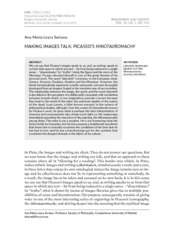Приказ основних података о документу
Making Images Talk: Picasso’s Minotauromachy
| dc.creator | Soriano, Ana María Leyra | |
| dc.date.accessioned | 2019-04-23T11:31:00Z | |
| dc.date.available | 2019-04-23T11:31:00Z | |
| dc.date.issued | 2019 | |
| dc.identifier.issn | 0353-5738 | |
| dc.identifier.uri | http://journal.instifdt.bg.ac.rs/index.php?journal=fid&page=article&op=view&path%5B%5D=https%3A%2F%2Fdoi.org%2F10.2298%2FFID1901019L | |
| dc.identifier.uri | http://rifdt.instifdt.bg.ac.rs/123456789/1949 | |
| dc.description.abstract | We can say that Picasso’s images speak to us, and, as writing, speak to us from that space in which any text – far from being reduced to a single sense – “disseminates” its “truths”. Using the figure and the story of the Minotaur, Picasso devoted himself to one of the great themes of his pictorial work. The word “labyrinth” connotes, to the European mind, Greece, Knossos, Dedalus, Ariadne and the Minotaur. However, the Greek formula already represents a mythic and poetic outcome thoroughly developed from an imagery forged in the remotest eras of our evolution. The relationship between the image, the spiral, and the word, labyrinth is also linked to the perception of a drilled earth, excavated, with numberless tortuous tunnels which, in our imagination, provoke concern because they lead to the world of the inferi, the unknown depths of the realms of the dead. Juan Larrea, a little-known essayist in the sphere of philosophical studies, although, from the outset of international renown for Picasso’s work, he gives what is perhaps the best interpretation of Guernica and consequently also sheds much light on the engravings immediately preceding the execution of this painting, the Minotauromachy among them. The artist is not a prophet. He is not foreseeing what the future holds for humanity, but he does possess a heightened sensitivity that drives him to minutely scrutinise the conditions of the time that he has had to live, and he has a transforming eye for the symbols that constitute the deepest threads in the fabric of his culture. | en |
| dc.description.abstract | Možemo reći da nam Pikasove slike govore i, kao pismo, da nam govore iz prostora u kome bilo koji tekst – daleko od toga da bude sveden na jedan smisao – “diseminira” svoje “istine”. Koristeći figuru i priču o Minotauru, Pikaso se posvetio jednoj od velikih tema svog slikovnog dela. Reč „lavirint“ konotira, evropskom duhu, Grčku, Knosos, Dedala, Arijadnu i Minotaura. Međutim, ta grčka formula već predstavlja mitski i poetski ishod temeljno izveden iz imaginarijuma stvorenog u najdavnijem dobu našeg našeg razvoja. Odnos između slike, spirale i reči, lavirint je takođe povezan sa izbušenom zemljom, prokopanom, sa bezbrojnim vijugavim tunelima koji u našoj imaginaciji izazivaju nelagodnost, jer vode u svet koji čine inferi, nepoznate dubine carstva mrtvih. Huan Larea, malo poznati esejist u oblasti filozofskih studija, iako, od samog početka, međunarodnog ugleda za Pikasovo delo, daje verovatno najbolje tumačenje Gernike i posledično u velikoj meri rasvetljava grafike koje neposredno prethode izradi ove slike, među njima i Minotauromahiju. Umetnik nije prorok. On ne predviđa šta budućnost donosi čovečanstvu, ali ipak poseduje pojačanu osetljivost da detaljno sagleda stanja vremena u kome mora da živi i ima preobražavalački pogled za simbole koji čine najdublje niti od kojih je satkana njegova kultura. | sr |
| dc.language.iso | en | sr |
| dc.publisher | Beograd : Institut za filozofiju i društvenu teoriju | sr |
| dc.rights | openAccess | sr |
| dc.rights.uri | https://creativecommons.org/licenses/by-nc-nd/4.0/ | |
| dc.source | Filozofija i društvo/Philosophy and Society | sr |
| dc.subject | labyrinth | sr |
| dc.subject | archetypes | sr |
| dc.subject | spanish civil war | sr |
| dc.subject | minotauromachy | sr |
| dc.subject | Guernica | sr |
| dc.subject | aesthetics | sr |
| dc.title | Making Images Talk: Picasso’s Minotauromachy | sr |
| dc.type | article | sr |
| dc.rights.license | BY-NC-ND | sr |
| dcterms.abstract | Сориано, Aна Марíа Леyра; | |
| dc.citation.issue | 1 | |
| dc.citation.volume | 30 | |
| dc.citation.spage | 19 | |
| dc.citation.epage | 29 | |
| dc.identifier.doi | 10.2298/FID1901019L | |
| dc.type.version | publishedVersion | sr |
| dc.identifier.fulltext | http://rifdt.instifdt.bg.ac.rs/bitstream/id/4516/bitstream_4516.pdf |

